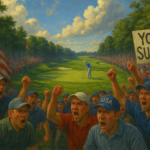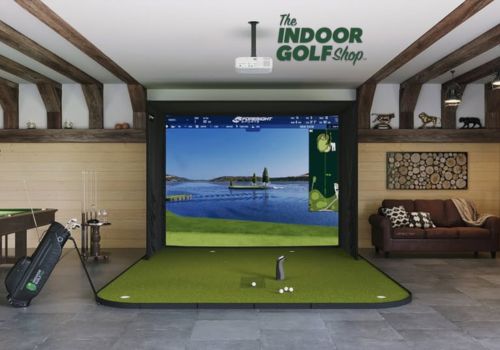Hey there, fellow golf enthusiasts! Let’s chat about something we’ve all noticed as we’ve gotten a bit more seasoned. You know how it goes – we step up to the tee, give it our best swing, and… well, the ball just doesn’t fly quite as far as it used to. Frustrating, right? Don’t worry, you’re not alone in this! Let’s take a closer look at why we might be losing some distance and chat about the steps we can take to fix this together as senior golfers.
Time to read: 7minutes
As we age, our bodies go through changes that can affect our golf game. Our muscles aren’t as strong as they used to be, which means our swing speed slows down and we can’t generate as much power. We also get stiffer, making it harder to turn our hips and shoulders like we used to. Our balance and coordination might not be what they once were, making it trickier to hit the sweet spot consistently.

But don’t give up just yet! There are plenty of things we can do to keep our drives from shrinking too much. Starting a golf-focused fitness routine can help keep our muscles strong and our bodies limber. Working with a pro to tweak our swing can help us make the most of what we’ve got. And don’t forget about the advances in golf technology – the right equipment can make a big difference.
The Science Behind Our Shrinking Drives
Our Muscles Aren’t What They Used to Be
First up, let’s talk muscles. As we age, we start losing muscle faster than we lose golf balls in the rough. This process, called sarcopenia, starts sneaking up on us around 30 and really kicks in after 50. For us golfers, this means:
- Our swing speed slows down
- We can’t generate as much power
- Our lower body doesn’t explode through the ball like before
Flexibility? More Like Stiffness
Remember when touching your toes was easy? Yeah, me neither. As we age, we get stiffer, and that really affects our golf swing:
- Our backswings get shorter
- We can’t turn our hips and shoulders as much
- Keeping good posture throughout the swing gets tougher
Balance and Coordination Aren’t What They Used to Be
Ever notice you’re not as steady on your feet? That’s because our nervous system slows down a bit, which can really mess with our golf game:
- Our stance might get a bit wobbly during the swing
- Shifting weight from back foot to front isn’t as smooth
- Hitting the sweet spot becomes trickier
Running Out of Steam Faster
Let’s face it, we don’t have the energy we used to. We need more time to recover, and we might start feeling tired before we even make the turn:
- Our performance might dip as the round goes on
- Our swing might get a little off when we’re tired
- Staying focused for 18 holes gets harder
Swing Changes Sneaking Up on Us
Without realizing it, we might start changing our swing to make up for these physical changes. The problem is, these changes aren’t always helpful:
- We might not transfer energy from our body to the club as well
- Our clubhead speed at impact might slow down
- Our ball striking might become less consistent

How to Fight Back Against Father Time
Don’t give up just yet! While we can’t stop time, there’s plenty we can do to keep our drives from shrinking too much.
Get Moving
One of the best things we can do is start a golf-focused fitness routine. I’m not talking about becoming a gym rat, but a little exercise can go a long way:
- Try some resistance training to keep those muscles strong
- Work on your core to improve stability and power
- Do some stretching to stay limber for those big swings
Tweak That Swing
It might be time to get some help from a pro. They can help you adjust your swing to make the most of what you’ve got:
- Focus on keeping a wide arc in your backswing
- Work on a smooth transition and good tempo
- Make sure you’re using your whole body, not just your arms
Gear Up Right
Technology’s come a long way, and the right equipment can make a big difference:
- Try lighter shafts to help you swing faster
- Look into drivers with more loft to get that ball up in the air
- Consider clubs with bigger sweet spots for more forgiveness
Play Smarter, Not Harder
Sometimes, scoring well isn’t about hitting it a mile, but playing to your strengths:
- Focus on accuracy rather than distance
- Don’t be too proud to move up a tee box if needed
- Work on your short game – it can save a lot of strokes
Fuel Your Body Right
What you eat and drink can make a big difference in how you feel on the course:
- Eat a good meal before you play
- Stay hydrated throughout your round
- Talk to your doctor about any helpful supplements
“You swing your best when you have the fewest things to think about.”
Bobby Jones
Keep Your Head in the Game
Half the battle is mental, so don’t let distance loss get you down:
- Set realistic goals for yourself
- Remember that there’s more to golf than just distance
- Try to stay positive, even when things aren’t going your way
Practical Tips to Squeeze Out a Few More Yards
Focus on Tempo
Sometimes, a smooth swing beats a hard swing. Work on finding a consistent tempo that feels good and produces results.
Turn, Baby, Turn
Even if you’re not as flexible as you used to be, focus on getting a good turn in your swing:
- Really rotate those shoulders in the backswing
- Start your downswing with your lower body
- Try to keep your spine angle throughout the swing
Use the Ground
Pushing off the ground can help you generate more power:
- Feel like you’re pushing against the ground with your legs as you swing
- Practice shifting your weight from your back foot to your front foot
- Keep your balance throughout the swing
Get the Launch Right
Talk to a pro or a club fitter about optimizing your launch conditions. They’ll look at things like:
- Launch angle
- Spin rate
- Ball speed
Stretch It Out
Doing some regular stretching can help keep you limber:
- Work on your hip flexibility
- Don’t forget about your shoulders and upper back
- Loosen up those ankles and wrists
Develop a Pre-Shot Routine
A good pre-shot routine can help you stay consistent:
- Visualize the shot you want to hit
- Take a practice swing or two
- Take a deep breath to calm your nerves
Try Different Golf Balls
Not all golf balls are created equal. Experiment with different types to find one that works best for your game.
We may earn a commission, at no additional cost to you.
Embracing the Golden Years of Golf
Now, I know losing distance can be frustrating, but remember, golf is a game we can play our whole lives. Many of us senior golfers find that our experience, course management, and touch around the greens more than make up for any yards we might’ve lost off the tee.
Plus, there’s a whole lot more to gain from golf than just distance:
- It gets us out walking and moving
- Keeps our minds sharp and gives us a chance to socialize
- Helps reduce stress and keeps us in a good mood
- Gives us a chance to compete and set goals for ourselves
Wrap-Up
Losing distance as we get older is just a fact of life for us senior golfers, but it doesn’t have to ruin our love for the game. By understanding why it’s happening and taking some steps to address it, we can keep enjoying golf well into our golden years.
Remember, golf isn’t just about how far you can hit it. It’s about the whole package – accuracy, short game, course management, and most importantly, having fun. Embrace the challenges that come with being a senior golfer, and you might just find that your game – and your enjoyment of it – is better than ever.
At the end of the day, the key to enjoying golf as we get older is to set realistic expectations, stay active, and keep a positive attitude. With the right mindset, you can keep challenging yourself, improving your skills, and enjoying the thrill of a well-struck shot for years to come.
- Beginners Advice
- Blog
- Golf 101
- Golf Club Advice
- Golf Fitness
- Golf Product Reviews
- Random and Fun
- Swing Improvement
- Mental Strategies to Help Senior Golfers Play Better
 ⛳️ Golf is more than a swing—it’s a mental game. For senior golfers, sharpening your focus, building confidence, and staying calm under pressure can make all the difference.
⛳️ Golf is more than a swing—it’s a mental game. For senior golfers, sharpening your focus, building confidence, and staying calm under pressure can make all the difference. - Golf Spectator Etiquette: How to Enjoy the Game Without Distracting the Pros (With Lessons from the 2025 Ryder Cup)
 Learn golf spectator etiquette with senior-friendly tips. Lessons from the 2025 Ryder Cup show why respect keeps the game enjoyable.
Learn golf spectator etiquette with senior-friendly tips. Lessons from the 2025 Ryder Cup show why respect keeps the game enjoyable. - Forward Tees: The Distinction of Being a Super Senior
 Experiencing something peculiar and delightful has been my reality in recent years. It’s been quite a transformation for me—I’ve become what they call a “super senior” golfer. Now, let me clarify,
Experiencing something peculiar and delightful has been my reality in recent years. It’s been quite a transformation for me—I’ve become what they call a “super senior” golfer. Now, let me clarify, - Best Golf Tips for Senior Golfers – Expanded Guide
 Whether you’ve been playing golf for decades or have only recently taken up the sport, being a senior golfer comes with its own set of challenges and opportunities.
Whether you’ve been playing golf for decades or have only recently taken up the sport, being a senior golfer comes with its own set of challenges and opportunities. - Effective Ways to Address Smoking on the Golf Course
 Smoking—especially cigar smoking—on the golf course is a long-standing tradition for some players, but it can also create tension within a group when not everyone enjoys or tolerates smoke. Addressing smokers in your group the right way requires a balance of respect, tact, and awareness of both etiquette and course policies. Smoking on the Golf… Read more: Effective Ways to Address Smoking on the Golf Course
Smoking—especially cigar smoking—on the golf course is a long-standing tradition for some players, but it can also create tension within a group when not everyone enjoys or tolerates smoke. Addressing smokers in your group the right way requires a balance of respect, tact, and awareness of both etiquette and course policies. Smoking on the Golf… Read more: Effective Ways to Address Smoking on the Golf Course




